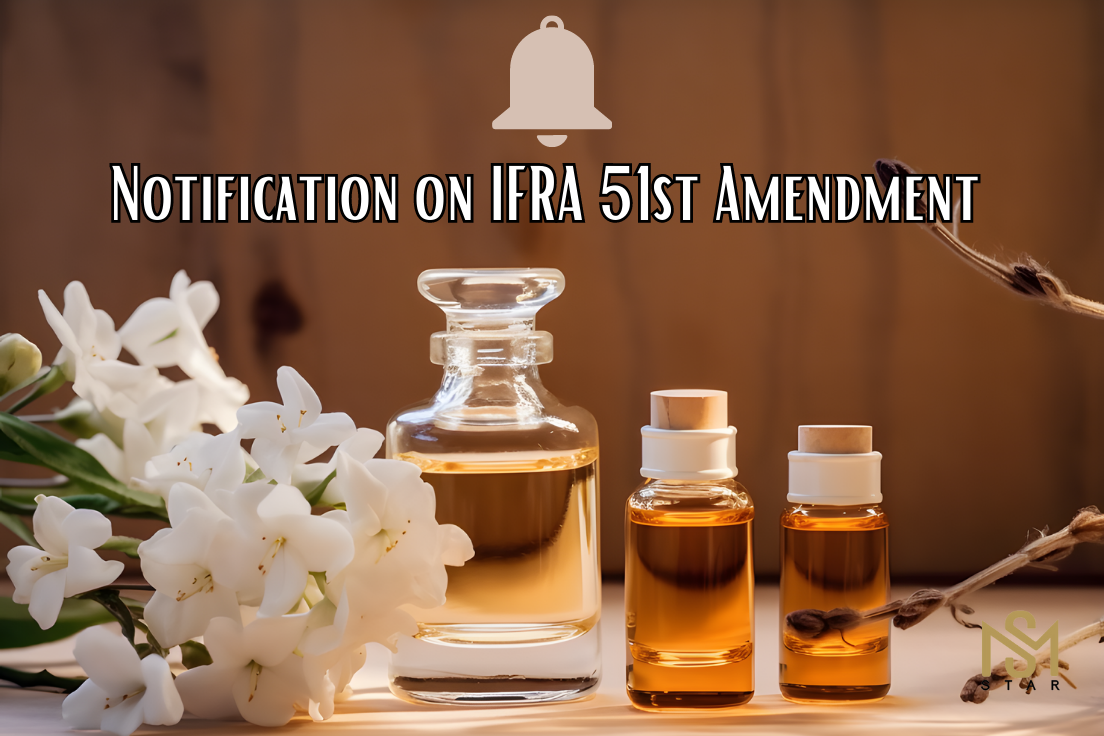OFFICIAL NOTICE ON IFRA 51st AMENDMENT
The consultation period on the 51st Amendment to IFRA standards ended in February 2023, and the International Perfumery Association (IFRA) announced its official revision notification on 30 June 2023.
Changes to the 51st Revision of IFRA Standards
- Description about paper products
- Explanation on classification of fabric softener sheets, dryer sheets and dry cleaning kits
- Cushion Spray category
- Classification of Reed Diffusers
- Processing of tracks
- Phototoxicity considerations for products in category 6
- Removal of “sunscreen” terminology in the manual
- Statement that the make-up remover for the face and eyes also includes the possibility of exposure to the lips
- Statement on “all types of aftershave” in category 4
New Standards
1 new IFRA Restriction Standard:
- “Allyl-3-cyclohexylpropionate”/INCI name Allyl cyclohexylpropionate (CAS no 2705-87-5)
32 new IFRA Restriction Standards based on skin sensitization and systemic toxicity:
- 4-tert-Butylcyclohexanone (CAS no 98-53-3)
- 1-(2-tert.-Butyl cyclohexyloxy)-2-butanol (CAS no 139504-68-0)
- Carvomenthone (CAS no 499-70-7/ 59471-80-6)
- Citronellyl acetate (CAS no 150-84-5/ 67601-05-2/ 141-11-7)
- Cyclohexadecanone (CAS no 2550-52-9)
- Cyclohexadecenone (CAS no 88642-03-9/ 5365-06-0/ 2550-59-6/ 3100-36-5/ 5120-20-7/ 854373-71-0/ 854373-70-9
- alpha-Cyclohexylidene benzeneacetonitrile (CAS no 10461-98-0)
- 2-Cyclohexylidene-2-ortho-tolylacetonitrile (CAS no 916887-53-1)
- Dimethyl octenone (CAS no 2550-11-0)
- (Ethoxymethoxy)-cyclododecane (CAS no 58567-11-6)
- Ethyl and Methyl furaneo (CAS no 27538-09-6/ 27538-10-9)
- Ethyl isopropyl bicycloheptene-2-carboxylate (CAS no 116044-44-1/ 116126-82-0)
- cis-3-Heptenyl acetate (CAS no 1576-78-9)
- cis-3-Hexenyl isovalerate (CAS no 35154-45-1)
- cis-3-Hexenyl methyl carbonate (CAS no 67633-96-9)
- 6-Hydroxy-2,6-dimethylheptanal (CAS no 62439-42-3)
- Isobutyl cinnamate (CAS no 122-67-8)
- Isoeugenyl acetate (CAS no 93-29-8)
- Isopentylcyclohexanone (CAS no 16587-71-6)
- 2-Methyl-2-pentenal (CAS no 623-36-9)
- 3-Methyl-5-phenylpent-2-enenitrile (CAS no 93893-89-1/ 53243-59-7/ 53243-60-0)
- 4-Methyl-1-propan-2-ylbicyclo[2.2.2]oct-2-ene-8-carboxylate (CAS no 68966-86-9)
- Methyl vanillyl ether (CAS no 5533-03-9)
- cis-3-Nonenyl acetate (CAS no 13049-88-2)
- 3,4,5,6,6-Pentamethylhept-3-en-2-one (CAS no 81786-75-6/ 81786-73-4/ 86115-11-9/ 81786-74-5)
- Phenoxyacetaldehyde (CAS no 2120-70-9)
- Tetramethyl bicyclo-2-heptene-2-propionaldehyde (CAS no 33885-52-8)
- 2,4,4,7-Tetramethyl-6-octen-3-one (CAS no 74338-72-0)
- 1-(2,2,6-Trimethylcyclohexyl)-3-hexanol (CAS no 70788-30-6)
- 1-(2,2,6-Trimethylcyclohexyl)-3-pentanol (CAS no 60241-52-3/ 60241-53-4)
- 3,6,7-Trimethyl-2,6-octadienal (CAS no 1891-67-4)
- Woody furan (CAS no 338735-71-0, 351343-77-6)
11 new IFRA Restriction Standards to control potential dermal sensitization effects based on QRA2 alone:
- alpha-Amylcinnamicaldehyde diethyl acetal (CAS no 60763-41-9)
- alpha-Amylcinnamicaldehyde dimethyl acetal (CAS no 91-87-2)
- Carvyl acetate (CAS no 97-42-7/ 1205-42-1/ 1134-95-8)
- 5-Hexen-1-yl 2-methylbutanoate (CAS no 155514-23-1)
- 2-Hexylidenecyclohexan-1-one (CAS no 16429-07-5)
- Methyl lavender ketone (CAS no 67801-33-6/ 67633-95-8)
- Myraldyl acetate (CAS no 72403-67-9)
- 2-Octen-4-one (CAS no 4643-27-0)
- 3-Octen-2-one (CAS no 1669-44-9)
- Octahydro-dimethylnaphthalene-2-carbaldehyde (mixed isomers) (CAS no 68738-94-3/ 68738-96-5/ 68991-96-8/ 68991-97-9)
- 2,5-Octadien-4-one, 5,6,7-trimethyl-, (2E)- (CAS no 358331-95-0/ 357650-26-1/ 847144-75-6)
2 new IFRA Restriction Standards where risk management is based on Systemic Toxicity (TTC):
- Methoxycyclododecane (CAS no 2986-54-1) and
- 7-Methoxy-3,7-dimethyloct-1-ene (CAS no 53767-86-5)
1 new IFRA Restriction Standard due to potential for depigmentation:
- p-Cresol (CAS no 1319-77-3, 106-44-5)
1 new IFRA Prohibition Standard due to potential genotoxic effects:
- 3-Acetyl-2,5-dimethylfuran (CAS no 10599-70-9)
Revised Standards
7 revised IFRA Restriction Standards to control for potential dermal sensitization effects for which systemic toxicity endpoints are now evaluated:
- Dihydrocoumarin (CAS no 119-84-6),
- Eugenol (CAS no 97-53-0),
- Geraniol (CAS no 106-24-1),
- 2-Hexenal ( CAS no 6728-26-3/ 505-57-7/16635-54-4),
- Hydroxycitronellal (CAS no 107-75-5),
- p-Methoxybenzaldehyde (CAS no 123-11-5),
- 4-Methoxy-alpha-mehtylbenzenepropanal (CAS no 5462-06-6)
1 revised IFRA Restriction Standard based on dermal sensitivity data:
- 3-Propylidenephthalide (CAS no 17369-59-4)
1 revised IFRA Restriction Standard and 1 updated Standard on Maximum Acceptable Concentration (MAC) in Category 6 based on phototoxicity and systemic toxicity:
- Methyl-N-methylanthranilate (CAS no 85-91-6, revised Standard), and
- Tagetes oil and absolute (CAS no 91722-29-1/ 8016-84-0/ 91770-75-1, updated standart)
2 revised IFRA Restriction Standards based on systemic toxicity:
- Estragole (CAS no 140-67-0/ 1407-27-8/ 77525-18-9)
- Methyl eugenol (CAS no 93-15-2)
Minor Updates and Format Changes to Current Standards
- Revised Restriction Standard: Farnesol. More CAS numbers (106-28-5 (2E, 6E) and 3790-71-4 (2Z, 6E)) have been added to the standard for clarity.
- Revised Prohibition Standard: Mintlactone. For clarity, another CAS number (38049-04-6) has been added to the standard.
The timelines provided in the standards refer to mixtures of fragrance ingredients (formulas) and not for the finished consumer product(s). The date of compliance with the IFRA Amendments corresponds to the date that fragrance blends are put on the market, that is, they leave a fragrance house. For documentation purposes, this date should be considered the earliest of the shipping date/or invoice dates.
“New creations” are defined as any fragrance mix that is arranged at the request of the customer after the completion of the exchange of information throughout the supply chain period. In practice, this means that briefings received after the Notice can only be verified for compliance with the requirements of the new Amendment once companies are fully operational.
“Existing creations” are fragrance blends that have already been released in a consumer product(s) or that are currently under development at the time the information exchange ends. This covers;
- Fragrance mixtures briefed before the date of the Change Notification;
- Fragrance mixes briefed during the exchange of information throughout the supply chain;
- Fragrance blends that are already being developed by the fragrance manufacturer or even in the possession of the consumer.
Timeline:
| IFRA Standards | Date for Standards entering into force for new creations | Date for Standards entering into force for existing creations |
| Standard prohibiting the use of ingredients | 2 months after the date of the letter of Notification (i.e. 30 August 2023) | 13 months after the date of the letter of Notification (i.e. 30 July 2024) |
| Standards restricting the use of ingredients or setting specifications | 9 months after the date of the letter of Notification (i.e. 30 March 2024) | 13 months after the date of the letter of Notification (i.e. 30 July 2024) |
With this change, cosmetics manufacturers must pay attention to the new standards of IFRA. It is important to obtain a declaration from the suppliers for the existing fragrance in the products of cosmetic manufacturers and to check the composition of the fragrance.


